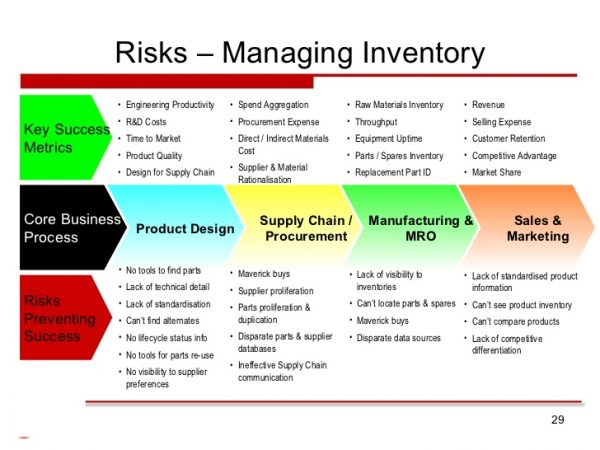How To Minimize The Risk In Supply Chain
 Risk is has always been part of a business and the supply chain is not excluded. A business derives strength the chain of supplier it works with and it is imperative that it takes preemptive measures to reduce the risk involved.
Risk is has always been part of a business and the supply chain is not excluded. A business derives strength the chain of supplier it works with and it is imperative that it takes preemptive measures to reduce the risk involved.
In a globalized economy where finalized products have components manufactured all over the world, effective management of supply chains is critical. The parties in the supply chain are linked to each other and therefore, they cannot be productive if one of the parties fails
Risk management in the supply chain has become increasingly essential as companies and businesses are in search of ways to expand their businesses. Enterprises entering new markets often need to form new supplier relationships, engage with state-owned entities, and adapt to local laws and culture. Thus, the complex nature of the supply chain can pose a lot of risk.
Business owners must be aware of this risk and also understand the component of strong supply chain risk management. Timely arrival of goods, managing vendor relationships, building strong payment protocols as well as knowledge of geographical challenges are measures that can help minimize problems in the supply chain. Pro active risk management has also been concluded to be the best as it is cost effective, ensures brand success and improves business growth.
As your company makes strategic choices, such as expanding geographic reach and taking on the related risks, you need to effectively manage risk from beginning to end. This mindset can help your organization gain competitive advantage, maintain your brand’s reputation, and ultimately, use an understanding of risk to drive performance.
Managing supply chain risk involves four processes which are identification, assessment, controlling, and monitoring of supply-chain risks. However, these processes might not be helpful for some type of supply chain. Therefore, the concept of supply-chain risk management is combined with the concept of supply-chain resilience, which aims to ensure that the supply chain can bounce back from risks irrespective of their cause. Supply chain resilience is the adaptive capability of the supply chain to prepare for unexpected events, respond to disruptions, and recover from them by maintaining continuity of operations at the desired level of connectedness and control over structure and function. However we will focus on supply chain risk management.
These are ways through which you can effectively minimize the risk involved in supply chain.
Know your supply chain neighbor.
Manufacturers need to know their suppliers as well as the businesses distributing and selling their products and vice versa. Each of the parties involve in the transaction must know whether the other party will be able to perform the duties assigned to him. These parties must also be able to identify if the standard of the other party is not one that will destabilize the company and create more problems for it. The kind of suppliers that you have can make or mar your business so be careful to make the right choice.
Monitor the quality of goods and services:
Carefully ensure that the quality and quantity received are up to the requirements set out in your contract with the supplier. Although you might have done some background check on your supplier, you might realize that in the course of business transaction, the quality of goods provided by the supplier could be of inferior quality and this could affect your business.
Pay for goods received
To ensure that a supplier’s invoice corresponds precisely to the goods or services you’ve actually received, you should have an account-payable process. Having a complex network of contractors can increase the risk of supply chain waste and fraud as there would be duplicate billing, inappropriate markups, and improper related-party billing.
Settle disputes effectively
Unsettled dispute can increase the risk involved in supply chain as they hinder smooth operations of the business.Disputes are expected at each stage of the supply chain. One key to mitigating dispute-related is to proactively prevent disputes from occurring or resolve them amicably if they happen. Ensure that the suppliers have good communication skills that will not increase risk, disrupt the ongoing supply chain and also add value to your company.
Match your exposure to involvement.
A supply chain party should not assume liability exposure which dwarfs the profit created by the transaction or relationship. For example, a component supplier making a one dollar profit on a widget should be reluctant to assume unlimited liability exposure for the upstream use of that widget, particularly where the use of the widget is outside of the supplier’s control. Otherwise, that supplier has essentially become the world’s cheapest insurer of the upstream parties.
Create detailed and robust contracts.
Good contracts prevent the manufacturer from exposure to liability — without protection and legal recourse against the responsible party — and at the mercy of the laws of other jurisdictions. It is vital that manufacturers and other supply chain parties have detailed and robust contracts for to ensure smooth relationships. This contract should also outline rights and obligations of the parties involved to create a balance and avoid dispute.
Have interlocking indemnity clauses throughout the supply chain.
The indemnity clause is a contract that shifts liability for losses and claims from the innocent party to the responsible party. Although indemnity clauses can be one sided, it is common for supply contracts to have mutual indemnity clauses. Unfortunately, indemnity clauses are often poorly drafted, overly broad, and misunderstood despite its importance. Indemnity clauses should be thoroughly examined tiny in any contractual negotiations.
Maintain sufficient insurance.
To minimize risk, you must be properly insured. Manufacturers and other supply chain parties often times complain of being uninsured or underinsured in product liability claims and other supply chain disputes. Therefore, it is important to understand and insure for such risk.
Seek home court advantage.
If a domestic party is dealing with foreign supply chain parties, there are a lot of challenges that would be encountered such as poor communication as well as poor access to information and required documents. The best way to mitigate the risks of dealing with foreign parties is to secure home court advantage through choice of law, choice of forum (courts), and/or arbitration clauses in supply contracts or terms and conditions.
Focus on your business and pay attention to details.
Do well to ensure that all contracts are carried out. Keep all the documents of all insurance policies, contracts, and commercial documents relating to the purchase and sale of any products, components, or raw materials. Good record keeping will often make or break product defect claims.







